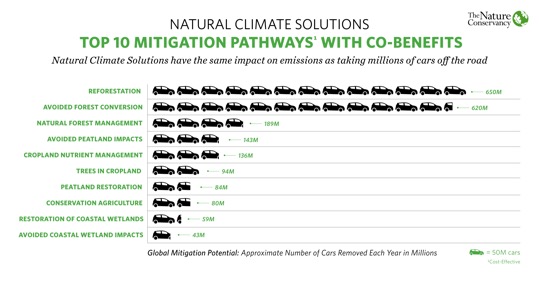 Improving the way people manage land could play a bigger role in fighting climate change than previously thought, according to a new study of how greenhouse gas emissions can be reduced and stored in forests, farmland, grasslands and wetlands.
Improving the way people manage land could play a bigger role in fighting climate change than previously thought, according to a new study of how greenhouse gas emissions can be reduced and stored in forests, farmland, grasslands and wetlands.
When implemented correctly, the natural solutions could cost-effectively deliver over a third of greenhouse gas emissions reductions required to prevent dangerous levels of global warming. This is equivalent to a complete stop to the burning of oil, worldwide.
The study, led by scientists from The Nature Conservancy, Colorado State University and 14 other institutions, was published Oct. 16 in Proceedings of the National Academy of Sciences.
Nearly 200 countries reached an agreement in December 2016 to take steps to keep the rise in global average temperatures to less than 2 degrees Celsius, or 3.6 degrees Fahrenheit. The agreement, reached at talks led by the United Nations in Paris, France, will be a challenge for countries to deliver on, said CSU’s Rich Conant, associate dean in the Warner College of Natural Resources and a co-author on the study.

“It’s going to be very difficult for the world to meet the goals set for limiting the rise in global average temperatures,” said Conant, a professor in the Department of Ecosystem Science and Sustainability and a member of the Natural Resource Ecology Laboratory.
Plants take in carbon dioxide from the air, keeping the carbon and giving away the oxygen. Burning fuels like coal, oil and natural gas uses oxygen and creates carbon dioxide. The more carbon dioxide in the air, the more of the sun’s energy gets trapped in the atmosphere as heat.
The research team identified 20 natural solutions that increase carbon storage and reduce greenhouse gas emissions across forests, wetlands, grasslands and farmlands. Solutions include restocking forests that have been depleted; avoiding the removal of forests for other needs, including agriculture; and using biochar, a charcoal, to help fortify soil. They also assessed the costs of the different options.
“We could, in theory, let all the lands that were forests be restored to forest land, but we need to grow food,” he explained. “We need to make sure that we don’t encourage practices that reduce the food supply or inhibit meeting people’s needs for food. Natural climate solutions will deliver a host of conservation benefits and are essential for drawing down atmospheric carbon dioxide concentrations.”
Mark Tercek, CEO of The Nature Conservancy, said impacts on the land currently cause one-quarter of greenhouse gas emissions.
“The way we manage the lands in the future could deliver 37 percent of the solution to climate change,” he said. “That is huge potential, so if we are serious about climate change, then we are going to have to get serious about investing in nature, as well as in clean energy and clean transport. We are going to have to increase food and timber production to meet the demand of a growing population, but we know we must do so in a way that addresses climate change.”
Technology already exists to draw carbon out of the atmosphere, a phenomenon known as negative emissions, said Conant. Factories that function like “artificial trees” mimic natural photosynthesis by treating polluted air with chemicals that react with carbon dioxide. The carbon-free air is returned to the atmosphere
“Technically, it’s feasible that systems like this could be established around the world,” he said.